Related articles
-
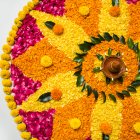 10 Exquisite Pongal Rangoli Designs to Celebrate the Harvest Festival With and Why You Should Practice This Ancient Art (2020)
10 Exquisite Pongal Rangoli Designs to Celebrate the Harvest Festival With and Why You Should Practice This Ancient Art (2020)
-
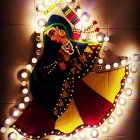 10 Divine Rangoli Designs for Navratri: Beautiful Rangolis To Welcome the Goddess and Also Good Luck to your Home! (Updated 2020)
10 Divine Rangoli Designs for Navratri: Beautiful Rangolis To Welcome the Goddess and Also Good Luck to your Home! (Updated 2020)
-
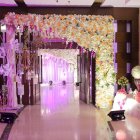 Want Everything Perfect and Spectacular on Wedding Day? Great Home Decor Ideas and DIY Tips for a Lavish Wedding to Leave a Lasting Impression on Your Guests (2020)
Want Everything Perfect and Spectacular on Wedding Day? Great Home Decor Ideas and DIY Tips for a Lavish Wedding to Leave a Lasting Impression on Your Guests (2020)
Significance of Ganesh Chaturthi
Ganesh Chaturthi is dedicated to Lord Ganesh, son of Lord Shiva and Goddess Parvathi. The festival falls on the fourth day after the new moon and a full moon. Ganesh Chaturthi is a festival celebrated in honour of Lord Ganesh. It is a ten-day festival that is observed to celebrate the birth of Lord Ganesh. The ten-day festival is celebrated either in August or September according to the Gregorian calendar. As per Hindu mythology, worshipping Lord Ganesh during Ganesh Chaturthi bestows one with wealth, prosperity and happiness. Moreover, one who is a devotee of Lord Ganesh is offered protection from obstacles and evil. Lord Ganesh is commonly associated with wisdom and knowledge. Observing a vrat and celebrating Ganesh Chaturthi is a sure way to seek his divine blessings.
Why Is Ganesh Chaturthi Celebrated?
According to Hindu mythology, Lord Ganesh wrote the Mahabharata in ten days based on Vyasa’s dictation. He had agreed to write the famous book on the condition that Vyasa dictated it continuously without taking time to pause. Moreover, Vyasa also made a pact with Lord Ganesh that before writing each word, he should understand the meaning before putting it down on paper. It took continuous ten days for both Vyasa and Lord Ganesh to complete writing the Mahabharata. During this process, they had neither water nor food.
Another story has it that, Goddess Parvathi created Lord Ganesh from dirt and asked him to stand guard while she was bathing. Lord Shiva unaware of Lord Ganesh demanded to see Parvathi and was denied entry by him. In a fit of rage, Lord Ganesh severed the head of Ganesh with a sword. Goddess Parvathi was devastated to see the headless body of her son and demanded Shiva to restore him. The other gods searched all through heaven and earth but were unable to find his real head. Finally, they returned with an elephant head that they were able to locate and Lord Shiva brought him back to life. The restoration of life is celebrated as the birthday of Lord Ganesh and celebrated as Ganesh Chaturthi.
Decoate Home and Work Spaces with Rangoli
Rangoli is derived from the Sanskrit word ‘rangavalli’. It signifies that rangoli is considered as an art that is compared to sculpture and painting. Rangolis are drawn during auspicious occasions and for festivals such as Diwali, Ganesh Chaturthi, etc. the beginning of the auspicious day is signified by drawing a colourful rangoli in front of one’s house. The common events during which a rangoli is drawn are religious festivals, auspicious events like wedding, ritualistic worship, etc. Along with auspiciousness, the rangoli brings forth the beauty of the symbols and patterns that are used in drawing. Rangolis are drawn using straight lines and with curved lines as well. Using these rangolis are freehand designs that are drawn with rangoli powder and filled with colours. However, nowadays, rangolis are drawn with stencils, glitters, salt with colours glitters and much more. Moreover, they are elaborately decorated with lamps, flowers, and designs that make them look more attractive.
Things You Need to Make Rangoli Designs and Patterns for Ganesh Chaturthi
You can draw a colourful rangoli pattern and seek the divine blessings of Lord Ganesh. Firstly, rangolis are of various types and comprise of numerous patterns.
- Rangoli drawn with lines, cones and circles proportionately to form a symbolic pattern.
- Freehand rangoli that usually comprises of flowers, leaves, trees, creepers, animals, and birds.
- Religious symbols and patterns such as a conch, Swastik, moon, sun, and others that are drawn with curved lines that are joined together.
- A lotus symbol comprising of eight petals that various directions of the Universe and also a symbol of Lord Vishnu and Goddess Saraswathi.
- Square rangoli, where a big square is divided into smaller squares and each square is filled with kumkum or vermillion to praise Lord Shiva.
- Dotted rangoli, numerous dots are connected to form various figures such as birds, animals, flowers, scenery, etc.
- Portrait rangoli where the picture of the deity is drawn and elaborately decorated with flowers, colours, and lamps.
Materials Used for Drawing Rangoli
- Rangoli powder – a fine powder that is used for drawing the rangoli outline wherein the colours are filled afterward.
- Chalk – an alternative to rangoli powder where it can also be used for drawing the outline.
- Rice flour – powdered rice flour can be used for drawing a rangoli. They are environment-friendly and also serve as food for birds and insects.
- Coloured rangoli powder – powders that are made from natural colours and synthetic colours. These colours are used for decorating the rangoli.
- Fine salt – To provide a glittering effect to your beautiful rangoli, fine or powdered sea salt can be mixed with colours to create a beautiful look.
- Coarse salt/Crystal salt – The crystal salt can be used for providing a 3D effect to your rangoli when they are mixed with colours.
- Flower petals – colourful and fragrant flower petals such as rose, sunflower, marigold, and lily are used for creating a rangoli.
- Fabric colours - can be used to create a rangoli pattern with brush and lots of creativity.
- Colored stones – coloured stones and rhinestones can be used for adding an element of elegance to your rangoli.
- Pulses – colourful pulses such as toor dal, chana dal, urad dal, and various dry bean seeds can be used for drawing a rangoli.
Tips for Drawing Rangoli Quickly and Easily
- Before starting, organize all the essential items that you would require for drawing the rangoli.
- Always outline with chalk, so that you easily erase if you have gone wrong.
- If you are a beginner, it is safe to go for abstract designs rather than trying difficult designs.
- Explore various designs using your creativity and draw them paper before you can draw them as a rangoli.
- You can also choose a floral design or a basic geometric design of animals, birds, God and Goddess.
- If you have no colours, fill your rangoli with natural colours available at homes such as salt, pulses, turmeric, and vermillion.
- Don’t overdo the decorations as they may cloud the beauty of your rangoli design.
10 Best Ganesh Chaturthi Rangoli Designs
1. Colourful Ganesh Rangoli
A freehand rangoli drawing made with colours and decorated with diyas.
- Draw the outline of the head of Lord Ganesh with white chalk.
- Draw floral patterns and patterns around the head of Lord Ganesh with chalk as well.
- Once the outline is completed, draw the outline with chalk powder.
- Fill the insides of the rangoli with a bright orange colour and the crown of Lord Ganesh.
- Draw the patterns, fill the rangoli floral patterns with coloured rangoli.
- Once the colours are filled, fill the rangoli with earthen lamps all around the rangoli.
2. Ganesha Chaturthi Special Rangoli
An awesome rangoli that is created from the religious symbol ‘Om’ in Hindi.
- With black rangoli powder, trace the trunk of Lord Ganesh by using a curve.
- Using red rangoli powder, trace the symbol ‘om’ in Hindi. The curve from the Hindi symbol must resemble the trunk drawn earlier.
- Fill the inside of the symbol with orange rangoli powder. Also, draw eyes on top to resemble Ganesh.
- Using yellow rangoli powder, draw a circle on the lower half and fill the inside as well. Using an earbud, trace abstract patterns inside the filled circle.
- Using various rangoli colours, draw s-shaped curves or squiggly lines along the outer border of the circle.,
- Place coloured powder mounds around the rangoli and flatten it using the backside of a tumbler. Once the mounds are flattened with an earbud drawn a spiral that resembles a flower.
3. Easy Freehand Rangoli Design
If you are a novice and not well-versed in drawing a rangoli, you can opt for a simple freehand rangoli. You can draw a charming rangoli and welcome Lord Ganesh into your home with this lovely rangoli. This is a simple rangoli that can be drawn without an outline.
- Use a small plastic bowl, draw two semi-circles adjacent to each other.
- Using your freehand draw a long curve that coils at the end with white rangoli powder. This should resemble the head of Lord Ganesh along with his trunk.
- Using green rangoli powder draw small ovals that are interlocked with each other to form a big pattern.
- Draw an inner boundary within the oval shape using yellow rangoli powder and fill the remaining area with blue rangoli powder.
- Fill the head of Lord Ganesh with yellow rangoli powder.
- Using your bangle, fill the inner side of the boundary by creating small mounds with pink rangoli powder.
- Using a pencil, place the pencil in the center of the mound and move the stick towards the center of the bangle to create floral patterns.
- Fill the space by drawing leaves around the flowers with green rangoli powder.
4. Ganesh Rangoli with Betal Leaves
An innovative rangoli that is drawn using crystals salt and decorations using flower petals and betel leaves.
- Trace the figurine of Lord Ganesh using rangoli colors mixed with salt crystals.
- Draw two circles encasing the figure – once small circle and another circle around it.
- Fill the inside of the circles with white crystal salt and draw colour filled triangles with alternately.
- Place betel leaves around the circles and decorate the inside of the betel leaf with coloured stones and rangoli powder.
- Decorate the edges of the betel leaves with flower petals and diyas.
5. Beautiful Kundan Rangoli
An elegant and beautiful rangoli that can be created using beads and coloured stones.
- Take white cardboard and trace the figure of Lord Ganesh with a pencil.
- Now using glue, stick golden beads around the figure of Lord Ganesh to create an outline.
- Fill the inside of the figure with coloured stones of various sizes – red, pink, blue and green.
- Place two red coloured stones for the eyes and create a crown using white zircon stones that are embedded with coloured stones as well.
6. Artificial Marigold Flower Rangoli
If you are running out of space and time, you can make your Ganesh Chaturthi rangoli by using artificial flowers. The rangoli tile artificial marigold flower mat can be placed on the floor. It measures 30 centimetres and is made of orange and yellow in colour. Orange and pink flowers are laid alternately and have gold trimmings around it. The center of the rangoli holds a gold-coloured candle stand that can be used for placing the diyas and scented candles. The gorgeous plastic flower rangoli can be purchased for Rs.555 from Amazon.
7. Rangoli Decorative Showpiece
A decorative rangoli piece that is made from acrylic that is perfect for homes. The acrylic piece is studded with sequins and stones by skilled artisans. These rangoli pieces can be arranged as per your desire making it perfect for festive occasions. The rangoli showpiece if intricately designed and is made of high-quality stones. The acrylic rangoli showpiece can be placed inside the house or outside as well. This gorgeous showpiece can be purchased for Rs.289 from Amazon.
8. Acrylic 3D Diya Rangoli
A beautiful 3D rangoli that is set to liven up your festivities. The 3D diya is made from acrylic and elaborately decorated with Kundan. That can be arranged. Moreover, the acrylic pieces are also lined and decorated with beads, coloured stones, and gold paint. The handmade 3D Diya rangoli is a perfect addition for your Ganesh Chaturthi celebrations. The creative acrylic 3D Diya rangoli can be purchased for Rs.249 from Amazon.
9. Ganesh Flower Rangoli
Flowers rangolis are famous in Kerala and are drawn during festive occasions such as Onam, Diwali and Ganesh Chaturthi.
- Trace the figurine of Lord Ganesh using chalk and then trace the outline using flower petals.
- Fill the inside of the figure with marigold, rose and jasmine flowers along with tulsi leaves.
- Fill the inside of the circles with cultured flower petals and draw color filled petals with alternately.
- You can further decorate the rangoli by placing diyas all around it or with coloured stones.
10. Edible Pulse Rangolia
An elegant rangoli that is drawn using edible pulses that can be reused later.
- On a clean and flat surface, trace the outline of Lord Ganesh with a pencil.
- Using white beans or white urad dal trace the pencil outline to create the figure outline.
- Fill the body of Lord Ganesh with yellow channa dal and his clothes with green mung dal.
- Fill the crown and jewellery of the lord using pink masoor dal.
- Finally fill the outside the remaining space outside the figure with black beans or mustard seeds.
Related articles
-
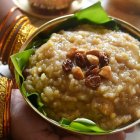 Want to Pamper Your Taste-Buds this Pongal? Here are Mouth-Watering Pongal Recipes You can't Miss in 2019
Want to Pamper Your Taste-Buds this Pongal? Here are Mouth-Watering Pongal Recipes You can't Miss in 2019
-
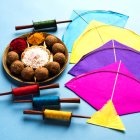 Start This Auspicious Day By Sending Beautiful Makar Sankranti Wishes to Everyone! Festive Greetings, Gifts Ideas and Lots More (2019)
Start This Auspicious Day By Sending Beautiful Makar Sankranti Wishes to Everyone! Festive Greetings, Gifts Ideas and Lots More (2019)
-
 This Festive Season Spread Happiness with 11 Special Diwali Gift Packs (2019)
This Festive Season Spread Happiness with 11 Special Diwali Gift Packs (2019)
-
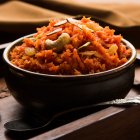 भारतीयों का मिठाई के लिए एक विशेष झुकाव है: 10 सबसे स्वादिष्ट भारतीय मिठाइयाँ विकल्प जिन्हे देख कर आपके मुंह में पानी आ जायेगा (2019)
भारतीयों का मिठाई के लिए एक विशेष झुकाव है: 10 सबसे स्वादिष्ट भारतीय मिठाइयाँ विकल्प जिन्हे देख कर आपके मुंह में पानी आ जायेगा (2019)
-
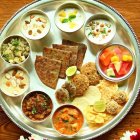 क्या आप नवरात्रि के लिए उपवास कर रहे हैं? यहां आपके लिए 9 नवरात्रि व्यंजन बनाने की विधि है जो आपके लिए शुद्ध, स्वादिष्ट और स्वस्थ की गारंटी है (2020)
क्या आप नवरात्रि के लिए उपवास कर रहे हैं? यहां आपके लिए 9 नवरात्रि व्यंजन बनाने की विधि है जो आपके लिए शुद्ध, स्वादिष्ट और स्वस्थ की गारंटी है (2020)
Go Simple
These are some of the best easy Ganpati rangoli designs we’ve put together for you. Since lord Ganpati is a part of every auspicious ceremony in India, having multiple options for easy Ganpati rangoli designs can't hurt as there would be a lot of occasions when you can use these. If you’re running out of time, but would still like to get your rangoli done. Go for easy Ganpati rangoli designs just like this one. Simple outlines are all you need to complete the rangoli. This type of rangoli doesn’t require too much of colours and wouldn’t be a messy affair at all!